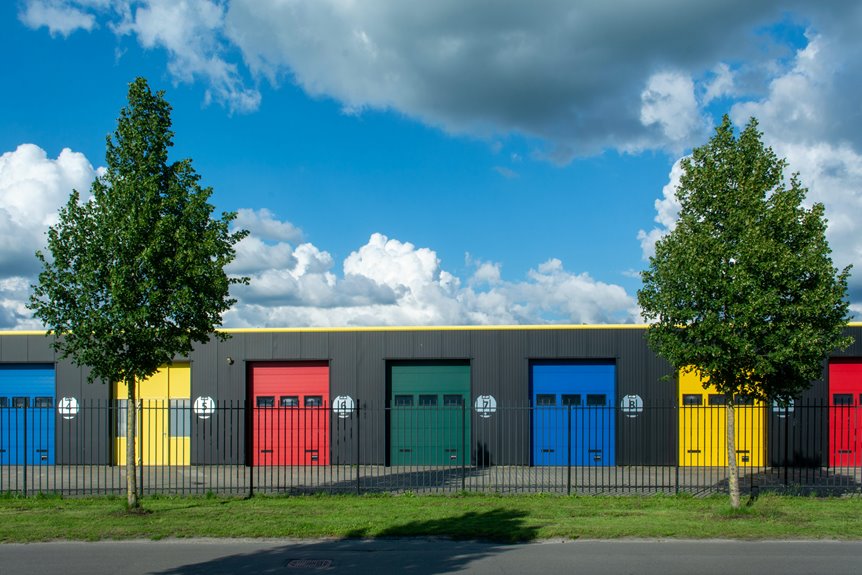As we contemplate the future landscape of commercial real estate, one can’t help but be intrigued by the interplay of various trends that are reshaping the industry. From the dynamic shift towards flexible workspaces to the ever-growing influence of technology on property management, the sector is undergoing a profound transformation. However, it’s the fusion of sustainable building practices, changing tenant preferences, and the relentless march of e-commerce that truly sets the stage for a thought-provoking journey into the evolving world of commercial real estate.
Key Takeaways
- Rise of flexible workspaces with hybrid layouts and remote work options.
- Technology integration enhancing workspaces with IoT and virtual collaboration tools.
- Sustainable building practices increasing demand for energy-efficient properties.
- E-commerce growth impacting warehouse demands and last-mile delivery logistics.
- Changing tenant preferences favoring flexible, sustainable, and experience-driven spaces.
Rise of Flexible Workspaces
I’ve noticed a significant increase in the popularity of flexible workspaces among commercial real estate tenants. It seems that more businesses are opting for the flexibility and adaptability that these spaces offer. Companies are recognizing the benefits of being able to scale their office space up or down based on their current needs. This trend is reshaping the traditional office leasing model and challenging landlords to think outside the box.
Flexible workspaces provide tenants with various options, from hot desking arrangements to fully serviced offices. This diversity allows businesses to choose a setup that aligns best with their operations and budget. Additionally, the collaborative environment fostered by flexible workspaces can enhance creativity and productivity among employees.
As a commercial real estate professional, I’ve seen firsthand how this shift towards flexible workspaces is influencing the industry. Landlords who can adapt to this trend stand to attract a wider range of tenants and maintain higher occupancy rates. It’s clear that the demand for flexible workspaces is here to stay, and those in the commercial real estate sector must be prepared to embrace this change.
Impact of Technology on Property Management
The integration of technology has revolutionized property management practices in the commercial real estate industry. As a property manager, I’ve witnessed firsthand how technology has streamlined operations, enhanced tenant experiences, and optimized building performance.
One key impact of technology is the adoption of smart building systems, allowing for real-time monitoring of energy usage, predictive maintenance, and increased security measures.
Moreover, property management software has become essential for efficiently managing leases, maintenance requests, and financial transactions. These digital platforms enable me to oversee multiple properties remotely, access important data on-the-go, and communicate effectively with tenants and vendors.
Additionally, the use of virtual reality and augmented reality tools has transformed the way properties are marketed and showcased to potential tenants. These immersive technologies provide a realistic and interactive experience, helping to attract and retain tenants in a competitive market.
Shift Towards Sustainable Buildings
The increasing focus on sustainability in the commercial real estate sector is driving a significant shift towards sustainable buildings. As a real estate professional, I’ve observed a growing demand for environmentally friendly and energy-efficient properties. This shift isn’t only fueled by environmental concerns but also by the potential cost savings and enhanced reputation that sustainable buildings offer.
Developers are increasingly incorporating green building practices into their projects, such as utilizing renewable energy sources, implementing efficient water management systems, and using eco-friendly materials. Additionally, certifications like LEED (Leadership in Energy and Environmental Design) are becoming more prevalent, highlighting a commitment to sustainability.
Investors are recognizing the long-term benefits of sustainable buildings, with studies showing that these properties tend to have higher occupancy rates, lower operating costs, and increased asset value over time. As a result, sustainable buildings aren’t just a trend but a strategic investment in the future of commercial real estate.
Influence of Remote Work on Office Design
As remote work reshapes the traditional office landscape, companies are embracing hybrid office layouts to accommodate both remote and in-person work. This shift has led to the adoption of flexible work arrangements that prioritize employee well-being and productivity.
To support these changes, office design is evolving to incorporate seamless technology integration for a more connected and efficient workspace.
Hybrid Office Layouts
Hybrid office layouts are evolving to accommodate the growing influence of remote work on office design. With more employees working remotely at least part of the time, companies are reimagining how office spaces can best support both in-person collaboration and individual work. These layouts prioritize flexibility, offering a mix of open areas for teamwork, private spaces for focused tasks, and amenities that enhance employee well-being.
One key feature of hybrid office layouts is the integration of technology to facilitate seamless communication between in-office and remote workers. This includes video conferencing capabilities, virtual collaboration tools, and smart scheduling systems to optimize space utilization.
Additionally, companies are incorporating modular furniture and reconfigurable spaces to adapt to changing needs.
Flexible Work Arrangements
Embracing the shift towards remote work, companies are redefining office design to accommodate flexible work arrangements. As a professional in the commercial real estate industry, I’ve observed a significant impact on office layouts due to the increasing prevalence of remote work.
Offices are now being designed with versatility in mind, offering spaces that cater to both collaborative in-person work and individual remote work needs. One prominent trend is the creation of adaptable workstations that can easily shift between personal desks and shared meeting areas. These flexible setups allow employees to choose the most suitable environment based on their tasks for the day.
Furthermore, companies are incorporating technology-driven solutions such as advanced video conferencing equipment and cloud-based collaboration tools to support seamless communication between remote and in-office team members.
Technology Integration
Incorporating tech-savvy solutions into office layouts to support remote work dynamics has become a pivotal focus in commercial real estate design. As the landscape of work continues to evolve, the influence of remote work on office design is undeniable.
Embracing this shift, commercial real estate professionals are reimagining spaces to cater to the needs of a tech-driven workforce. Here are five key aspects shaping the integration of technology in modern office design:
- Smart Office Features: Implementing IoT devices and sensors to enhance workplace efficiency.
- Virtual Collaboration Tools: Providing seamless platforms for remote teams to connect and collaborate.
- Flexible Furniture Configurations: Adaptable workstations to accommodate varying work styles and preferences.
- Cloud-Based Infrastructure: Leveraging cloud technology for scalable and secure data management.
- Augmented Reality Experiences: Incorporating AR for virtual tours and interactive office layouts.
Growth of E-Commerce and Industrial Properties
I’ll highlight the significant impact of e-commerce on the industrial real estate sector. Particularly, the surge in demand for warehouses and distribution centers due to the growth of online shopping.
This trend is reshaping the landscape of industrial properties. Companies are seeking larger spaces and locations closer to urban centers to meet consumer demands efficiently.
As e-commerce continues to thrive, the need for industrial real estate is expected to increase. This presents lucrative opportunities for investors and developers in this sector.
E-Commerce Impact on Warehouses
The surge in online shopping has greatly strengthened the demand for industrial properties, especially warehouses, due to the growth of e-commerce. As more consumers opt for the convenience of shopping online, the need for efficient warehousing and distribution centers has skyrocketed.
Here are five key impacts of e-commerce on warehouses:
- Increased Demand: E-commerce companies require more warehouse space to store inventory and fulfill orders promptly.
- Last-Mile Delivery: Warehouses located closer to urban centers are in high demand to facilitate quick last-mile deliveries to customers.
- Automation: The rise of e-commerce has led to greater investment in warehouse automation technologies to enhance efficiency.
- Adaptation of Spaces: Warehouses are being reimagined to accommodate the high volume of small, individual orders typical in e-commerce.
- Supply Chain Resilience: E-commerce growth has emphasized the importance of robust supply chains, driving the need for strategically located warehouses.
Demand for Industrial Space
Considering the substantial impact of e-commerce on the increased demand for industrial properties, an evident reflection can be witnessed in the growing need for industrial space. As online shopping continues to surge, retailers are reevaluating their supply chain strategies, opting for more efficient distribution networks. This shift has led to a notable rise in the demand for industrial properties, particularly warehouse and fulfillment centers.
E-commerce giants like Amazon have been at the forefront of this trend, rapidly expanding their logistics infrastructure to meet consumer demands for quick and convenient deliveries. As a result, industrial real estate developers are seeing unprecedented interest in developing or repurposing existing properties to cater to the needs of these online retailers.
The growth of e-commerce hasn’t only impacted the demand for industrial space but has also influenced its design and functionality. Modern warehouses are now being equipped with advanced technology such as automation and robotics to enhance efficiency and streamline operations. This evolution in industrial real estate is a clear indication of the changing landscape driven by the booming e-commerce industry.
Advancements in Data Analytics for Decision-Making
Exploring the latest innovations in data analytics has become essential for making informed decisions in the dynamic commercial real estate landscape. Leveraging data analytics can provide valuable insights that drive strategic decision-making and enhance operational efficiency.
Here are five key advancements in data analytics shaping the future of commercial real estate:
- Predictive Analytics: Utilizing predictive models to forecast trends and outcomes, aiding in proactive decision-making.
- Machine Learning Algorithms: Employing algorithms that can learn from data to identify patterns and make predictions without being explicitly programmed.
- Geospatial Analysis: Integrating location-based data to understand spatial relationships and make location-specific decisions.
- Real-Time Data Monitoring: Monitoring data streams in real-time to enable quick responses to changing market conditions.
- Risk Assessment Tools: Using advanced tools to assess risks associated with investments, developments, or portfolio management strategies.
These advancements empower real estate professionals to adapt to market fluctuations, optimize asset performance, and stay ahead in a competitive industry.
Changing Tenant Preferences and Demands
With commercial real estate evolving rapidly, understanding shifting tenant preferences and demands is essential for staying competitive in the market. As a commercial real estate professional, I’ve witnessed a noticeable change in what tenants are looking for in their office spaces. Gone are the days when a simple cubicle setup would suffice. Nowadays, tenants are increasingly seeking flexible workspace options that promote collaboration and creativity.
Open floor plans, communal areas, and amenities like fitness centers and on-site cafes have become must-haves for many tenants.
Additionally, sustainability has become a top priority for tenants. Green buildings with LEED certifications are highly sought after, as tenants are more conscious of their environmental impact. Proximity to public transportation and bike storage facilities are also factors that tenants consider when choosing office spaces.
In essence, by adapting to these changing preferences and demands, landlords and property managers can attract and retain high-quality tenants, ultimately ensuring the long-term success and profitability of their commercial real estate investments.
Evolution of Commercial Leasing Models
How have commercial leasing models evolved in response to changing market dynamics and tenant needs?
Commercial real estate leasing has undergone significant changes to adapt to the evolving needs of tenants and the shifting market landscape. Here are some key trends shaping the evolution of commercial leasing models:
- Flexible Lease Terms: Landlords are offering more flexibility in lease terms to accommodate changing business requirements.
- Coworking and Shared Spaces: The rise of coworking spaces has led to an increase in shared and flexible leasing options.
- Technology Integration: Leasing models now incorporate technology solutions for enhanced tenant experiences and operational efficiency.
- Sustainability Focus: There’s a growing emphasis on sustainable buildings and environmentally friendly leasing practices.
- Experience-driven Spaces: Landlords are creating experiential spaces that offer more than just a place to work, focusing on amenities and community-building activities.
Conclusion
As I reflect on the transformative trends shaping the future of commercial real estate, it becomes clear that adaptability and innovation will be key to success in this evolving industry.
The integration of flexible workspaces, technology, sustainability practices, and changing tenant preferences will require a dynamic approach to property management and leasing.
Embracing these shifts and staying ahead of the curve will be essential for staying competitive and meeting the demands of tomorrow’s commercial real estate market.
Frequently Asked Questions
How Will Virtual Reality Impact Property Viewings in the Future?
Virtual reality will revolutionize property viewings by offering immersive experiences and saving time for both buyers and sellers. I believe it will enhance decision-making and streamline the process in the future.
What Role Will Blockchain Play in Commercial Real Estate Transactions?
Blockchain will revolutionize commercial real estate transactions by providing secure, transparent, and efficient processes. Its decentralized nature guarantees trust and reduces fraud risks. Smart contracts will streamline deals, enhancing speed and accuracy in transactions.
Are There Any Regulations for Incorporating Green Roofs in Sustainable Buildings?
Incorporating green roofs in sustainable buildings is subject to various regulations. These rules often dictate the design, installation, and maintenance requirements to guarantee environmental benefits and compliance with local building codes and sustainability standards.
How Will Office Design Adapt to Accommodate Both Remote and In-Person Work?
I’m exploring ways office design can flex to support remote and in-person work seamlessly. Open layouts with adaptable spaces, advanced technology for virtual collaboration, and wellness-focused amenities are key for a productive and inclusive environment.
Can Data Analytics Predict Future Commercial Real Estate Market Trends Accurately?
Like a skilled navigator using a compass, I believe data analytics can accurately predict future commercial real estate market trends. I’ve seen its power firsthand, guiding decisions with precision and uncovering hidden opportunities.
Ready to make the next move in real estate? If you’re thinking of selling your property, don’t wait! At Cash4Houses, we buy homes quickly and hassle-free, offering you a fast cash offer that saves you time, money, and paperwork. Skip the traditional listing process and sell your property today! Get your fair cash offer now and start planning for the future.







